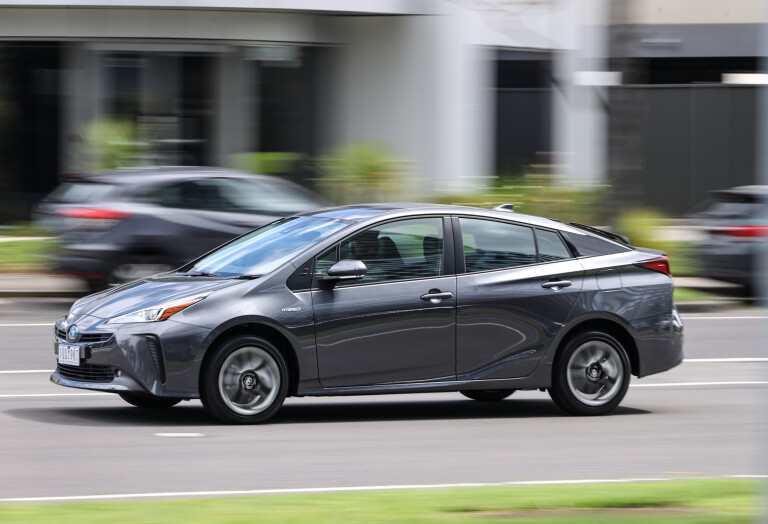
Score breakdown
Things we like
- Excellent fuel economy, even for a hybrid
- Boot space
- Urban ride comfort
- Quirky looks
Not so much
- Expensive when compared to other Toyota hybrids
- Nearing the end of its model life
- Lacklustre handling
- Quirky looks
UPDATE, November 2022: New-gen Prius unveiled
Toyota has revealed its new-generation Prius hybrid, revealing what is surely the most stylish iteration yet of what has historically been an awkwardly styled line of cars. Alas, this is also the first generation of Prius that won't come to Australia. Get all the details at the link below.
Story continues
It’s hard to believe that it has been 20 years since the Toyota Prius first went on sale around the world, including Australia, and quickly became synonymous with lower-emissions driving.
A lot has happened since, with Tesla becoming a household name and legacy brands gradually embracing the electric future with battery electric vehicles that mostly made the Prius and other hybrids seem a little ho-hum.
The Prius is now in its fourth generation, which is nearing the end of its life cycle. A fifth-generation model is slated for the 2023 model year.
But given every other soft-road Toyota passenger vehicle in Australia, from the Yaris to the Kluger, is now available with hybrid variants, why would anyone still want a Prius? Surely it's no longer the green status symbol it once was.
With this year’s Prius sales unlikely to reach 100 units – behind a number of pure-electric models and Toyota’s slowest seller unless you count the lease-only, hydrogen-powered Mirai – I jumped into a range-topping i-Tech version to find out what it still has to offer.

Pricing and ownership
The current Toyota Prius range was last updated in 2019 and consists of the eponymous entry-level variant the upper-spec Prius i-Tech, which retail for $38,365 and $45,825 respectively (before on-road costs).
Each has the same 1.8-litre four-cylinder engine coupled with an electric motor for a combined 90kW and an official combined fuel consumption of 3.4L/100km.
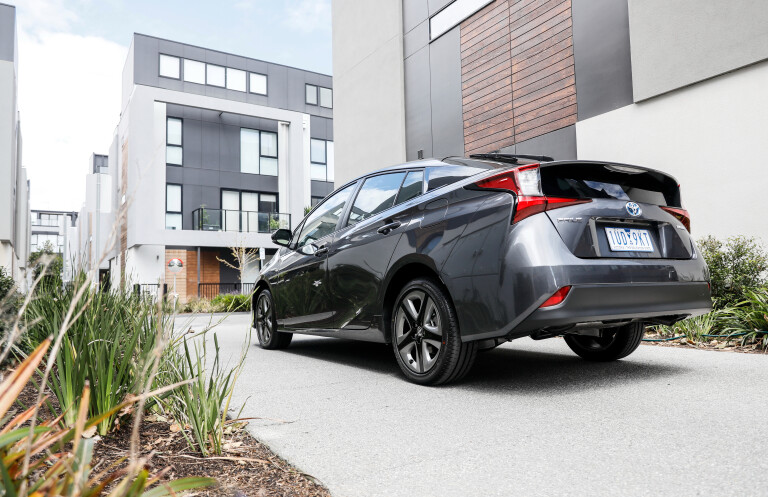
Interestingly, hybrid Corolla variants feature the same powertrain and 1400kg kerb weight but an official fuel consumption rating of 4.2L/100km, which says something for the Prius’ more aerodynamic form.
As far as real-world fuel economy is concerned, our test car sipped fuel at a rate of 3.2L/100km in urban areas but sometimes nudged 5.0L/100km on freeways. After 156km across a range of driving conditions, I averaged 4.7km/100km with the fuel gauge barely moving from the full position.
Service intervals for the Prius are a frequent six months or 10,000km, whichever comes first, with each visit to a Toyota service department capped at $205 under the Toyota Service Advantage scheme.
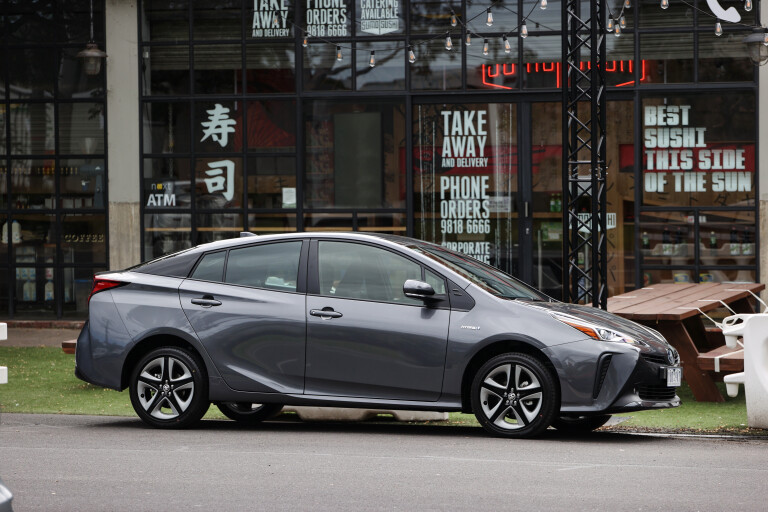
The Prius is covered by Toyota’s five-year, unlimited-kilometre warranty and seven-year anti-corrosion cover.
Features
The Prius has a generous standard features list, which includes a power-adjustable driver’s seat, head-up display, 7.0-inch touchscreen, satellite navigation, Apple CarPlay/Android Auto, AM/FM/DAB+ radio, 10-speaker JBL premium audio system, wireless phone charger, climate control air-conditioning, keyless entry/start, auto-dimming rearview mirror and 15-inch alloy wheels.
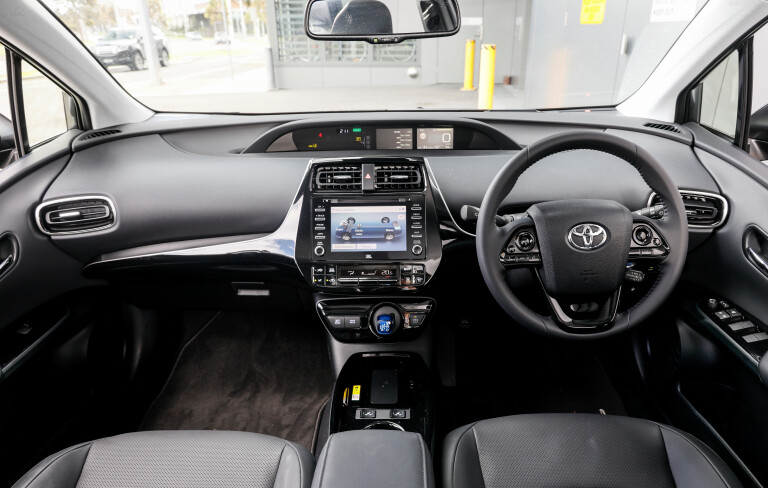
Spending a substantial $7460 more on the Prius i-Tech brings pleasantries such as leather accented seats, heated front seats, power-operated tailgate and smarter looking 17-inch alloys. Rear-cross traffic and blind-spot monitor are added to the safety suite, which we’ll go into below.
Extra-cost options are confined to premium paint, meaning you’ll have to pay an extra $600 if you want one of the other six hues over the standard Glacier White.
Space and comfort
The fourth-generation Prius has been around since 2016 and in March 2019 it received a facelift that brought more conventional-looking front- and rear-end treatments including sleeker LED headlights and rear combination lights.
The interior design was also tweaked with improved ergonomics, new cloth upholstery in the entry-level variant and a substantially upgraded multimedia system that brought Apple CarPlay and Android Auto smartphone mirroring.

The satellite navigation system features SUNA live traffic alerts but I preferred using Waze or Google Maps for real-time info. These also have sharper graphics than Toyota’s interface, which still looks like a shareware download from someone’s Geocities site.
That said, the in-built system does hook up to the head-up display (HUD) that shows the directions within your eye line.
The HUD also allows you to check your speed without having to look toward the centre of the dashboard where the gauge cluster is mounted above the central air vents and touchscreen.

Toyota also redesigned the centre console to incorporate two cup holders, seat heating switches and a wireless phone charger. It's clutter-free, with the milk-float-like gear shifter protruding from the lower part of the dashboard fascia below the air-conditioning controls.
The leather-appointed front seats are comfortable but could do with a little more upper-thigh support and once seated, there is good frontal vision despite the deep dashboard top that sees you sitting about a metre back from the lower part of the windscreen.
It’s behind the front seats where the Prius provides its own niche – filling the size gap between the Corolla and Camry.
The Prius has considerably more legroom than the Corolla, though this is undermined a little by the low swept-back roofline that can compromise headroom. And there isn’t much back there for passengers apart from a 12-volt socket, bottle holders in the doors, map pockets and a fold-down armrest with cup holders.
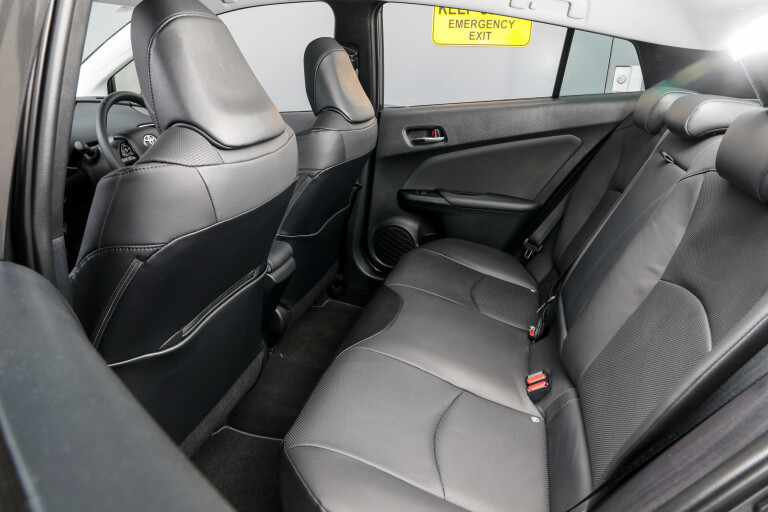
The boot space is a medium-SUV-like 502 litres, which is more than double the Corolla hatchback’s measly 217-litre cargo area. Folding down the 60:40 spilt rear seatbacks brings up to 1507 litres in which to carry stuff.
The long tailgate lifts very high, creating an aperture about the same size as the boot floor, which makes it easy to load bulky items.
On the downside, there is no spare wheel under the boot floor, just a goo kit to seal the tyre enough for you to take it to a repairer.
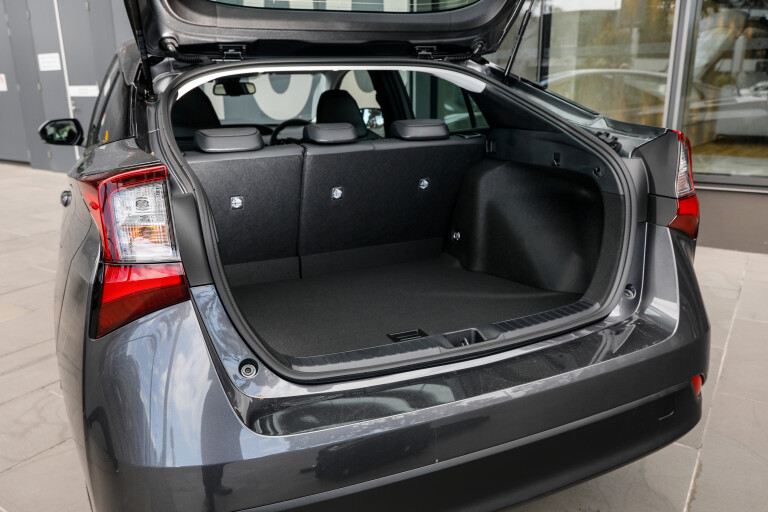
On the road
The Prius is powered by a 72kW/142Nm 1.8-litre four-cylinder Atkinson Cycle petrol engine that is coupled with an electric motor, resulting in a total maximum power output of 90kW, which is sent to the front wheels through a continuously variable transmission (CVT).
Despite the additional oomph, it feels underpowered and the engine screams into life when you put the foot down hard, not helped by the CVT.

It has a Sport driving mode that helps bring the revs up so you get closer to peak power quicker, but it still feels a little heavy.
There is also an EV mode that allows you to drive on the battery power alone for short distances, but its operation seems to have more conditions than a weekend rental agreement for a Ferrari – the battery has to be almost fully charged and you can barely travel more than walking pace.
It seems a bit gimmicky to me and not worth the effort.
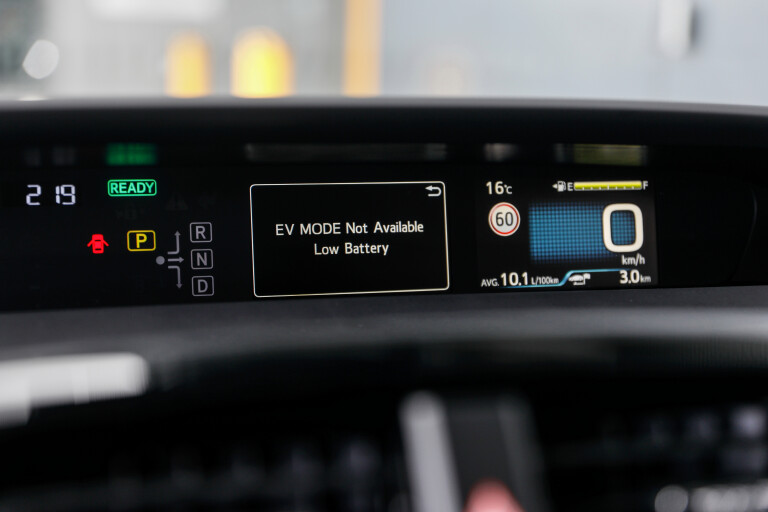
Once on the move, the handling feels rather prosaic. I took the Prius up Melbourne’s Dandenong Ranges where the speed limit on most roads is just 70km/h and I can’t say I was comfortable travelling around that speed on some of the twistier sections.
The steering offers little feel between your hands and tyres, and the car itself feels quite front-heavy, though the suspension does a good job of limiting body roll.
Like the Corolla, it rides on MacPherson strut front and double-wishbone rear suspension that works as a Jack of all trades and master of none – the ride is generally comfortable but susceptible to jarring over bigger bumps and potholes.
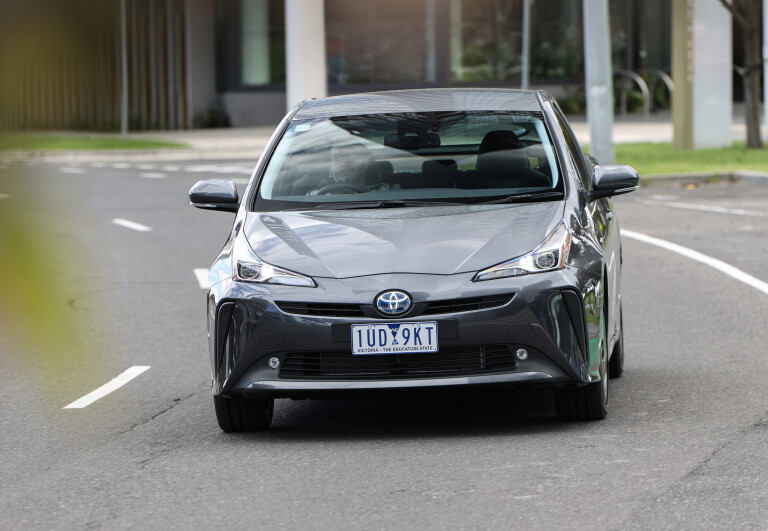
One thing I do like is the B setting on the gear shifter that beefs up the regenerative braking.
The stopping force isn’t as strong as the regenerative braking you get with a pure electric car but was enough to allow for one-pedal driving when coming back down the Dandenongs, thus saving me having to apply the actual brakes.
Once back from the hills, I found the Prius to be in its element around town and when highway cruising, where it offers a comfortable and quiet ride.

Safety
The Toyota Prius features Toyota Safety Sense that includes adaptive cruise control, forward collision warning, lane departure alert with steering assist, road-sign recognition, auto high beam, a reversing camera and seven airbags. Autonomous emergency braking is also included, but it lacks pedestrian and cyclist detection.
The Prius has a five-star ANCAP safety rating that was awarded in 2016.
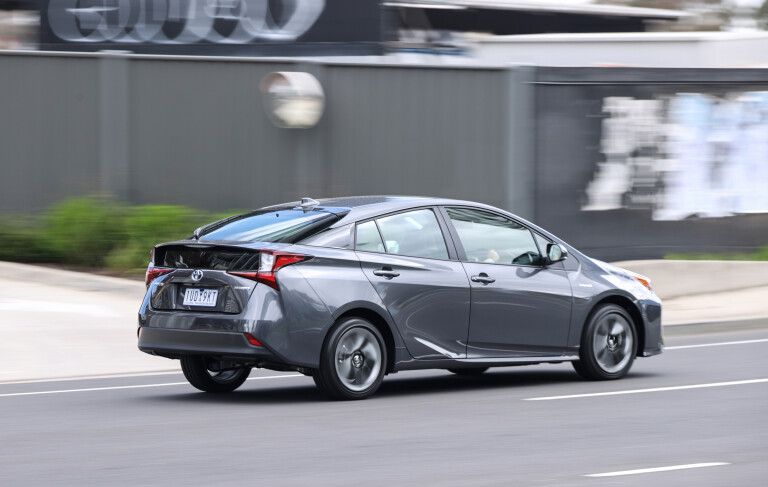
VERDICT
Apart from its excellent fuel economy and relatively quirky looks, I wish I could say there was something that still sets the Prius apart from its siblings to justify its hefty price tag.
Its frugalness, roomy rear seat and large boot space make it a great taxi, which probably accounts for most of its sales in 2021. But for the private buyer, its price range is a little high compared to the other Toyota hybrids, including the identically powered top-spec Corolla ZR that retails for $34,695 before on-roads and offers a more enjoyable driving experience.
Sure, the Prius is more practical than the Corolla, but anyone seeking a Toyota hybrid with a bigger boot has the Camry and four Toyota hybrid SUVs to choose from, not least the big-selling RAV4 Cruiser Auto eFour that comes with superior equipment levels, more power and part-time all-wheel-drive for just $600 more.
And if you’re sold on the liftback design, there is always the similarly sized and shaped but fresher Hyundai Ioniq, which is available with hybrid, plug-in hybrid and EV variants, most of which are more affordable than the Prius i-Tech.
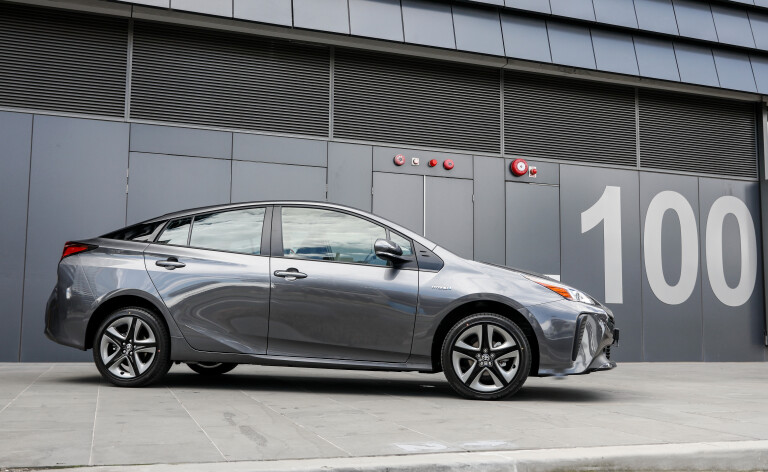
Toyota Prius i-Tech specifications
| Body | 5-door hatchback |
|---|---|
| Drive | front-wheel |
| Engine | 1.8L Atkinson Cycle, 4-cyl petrol hybrid |
| Max Power | 72kW @ 5200rpm |
| Combined (hybrid) power | 90kW |
| Max Torque | 142Nm @ 3600rpm |
| Transmission | automatic, continuously variable (CVT) |
| Bore & Stroke | 80.5 x 88.3mm |
| Compression Ratio | 13.0:1 |
| Fuel economy (combined) | 3.4L/100km |
| Suspension | MacPherson strut front / double wishbone rear |
| Weight | 1400kg |
| L/W/H | 4575mm/1760mm/1490mm |
| Wheelbase | 2700mm |
| Wheels | 17-inch alloy |
| Tyres | 215/45 R17 |
| Price | $45,825 before on-road costs |

Score breakdown
Things we like
- Excellent fuel economy, even for a hybrid
- Boot space
- Urban ride comfort
- Quirky looks
Not so much
- Expensive when compared to other Toyota hybrids
- Nearing the end of its model life
- Lacklustre handling
- Quirky looks

COMMENTS